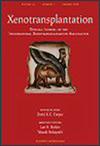人类 ST3Gal II 和 ST6GalNAc IV 基因可增强人类血清介导的异种细胞细胞毒性
IF 4.1
4区 医学
Q2 MEDICINE, RESEARCH & EXPERIMENTAL
引用次数: 0
摘要
广泛存在于所有哺乳动物细胞的糖蛋白和糖磷脂上的碳水化合物抗原在自卫和免疫中起着至关重要的作用。天然人类血清中的异种反应抗体在异种移植的急性排斥反应中起着保护作用。在这项研究中,我们研究了由人硅烷基转移酶(如 hST3Gal II 或 hST6GalNAc IV)引起的糖基化模式改变对猪肾 PK15 细胞中人血清介导的细胞毒性的影响。从 LDH 细胞毒性检测结果来看,与对照组相比,hST3Gal II 和 hST6GalNAc IV 转染的 PK15 细胞对人血清的细胞毒性明显增加。而携带 hST6Gal I 的细胞对人血清的细胞毒性反而降低了。此外,流式细胞仪分析表明,hST3Gal II 或 hST6GalNAc IV 对猪糖基化模式的改变分别影响猪肾细胞中人 IgM 或 IgG 的结合,与 Gal 抗原的改变无关。最后,我们发现,与对照组相比,hST6GalNAc IV转染的PK15细胞中MAL II凝集素结合能力的提高证明了hST6GalNAc IV有助于增加末端二氨酰化四糖结构--二氨酰基T抗原。因此,我们的研究结果表明,ST3Gal II- 和 ST6GalNAc IV 新合成的碳水化合物抗原,如二ialyl T 抗原,有可能被认为是新的异种反应元素。本文章由计算机程序翻译,如有差异,请以英文原文为准。
Human ST3Gal II and ST6GalNAc IV genes increase human serum‐mediated cytotoxicity to xenogeneic cells
Carbohydrate‐antigens widely existed on glycoproteins and glycosphingolipids of all mammalian cells play a crucial role in self‐defense and immunity. Xeno‐reactive antibodies included in natural human sera play a protecting role in an acute phase‐rejection of xenotransplantation. In this study, we investigated the effect of an alteration of glycosylation‐pattern, caused by human sialyltransferases such as hST3Gal II or hST6GalNAc IV, on human serum mediated cytotoxicity in pig kidney PK15 cells. From LDH cytotoxicity assay, cytotoxicity to human serum was significantly increased in hST3Gal II and hST6GalNAc IV‐transfected PK15 cells, as compared to the control. In the hST6Gal I‐carrying cells, the cytotoxicity to human serum was rather decreased. Moreover, flow cytometry analysis revealed that an alteration of pig glycosylation‐pattern by hST3Gal II or hST6GalNAc IV influences on a binding of human IgM or IgG, respectively, in pig kidney cells, regardless of Gal antigen alteration. Finally, we found that hST6GalNAc IV contributed to increase of terminal disialylated tetrasaccharide structure, disialyl T antigen, as evidenced by increase of the MAL II lectin binding capacity in the hST6GalNAc IV‐transfected PK15 cells, compared with control. Therefore, our results suggest that carbohydrate antigens, such as disialyl T antigen, newly synthesized by the ST3Gal II‐ and ST6GalNAc IV are potentially believed to be new xeno‐reactive elements.
求助全文
通过发布文献求助,成功后即可免费获取论文全文。
去求助
来源期刊

Xenotransplantation
医学-医学:研究与实验
CiteScore
6.80
自引率
15.40%
发文量
58
审稿时长
>12 weeks
期刊介绍:
Xenotransplantation provides its readership with rapid communication of new findings in the field of organ and tissue transplantation across species barriers.The journal is not only of interest to those whose primary area is xenotransplantation, but also to veterinarians, microbiologists and geneticists. It also investigates and reports on the controversial theological, ethical, legal and psychological implications of xenotransplantation.
 求助内容:
求助内容: 应助结果提醒方式:
应助结果提醒方式:


